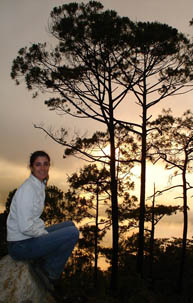Research & Discoveries: Rural-urban divide deepens
Research & Discoveries: Rural-urban divide deepens McGill University
User Tools (skip):
RESEARCH & DISCOVERIES
Rural-urban divide deepens
Trading social traditions for economic gain

Paola Bauche in the Rio Cuale Watershed.
COURTESY OF Paola Bauche
The usual story on forests is that they are being clear-cut and disappearing. But McGill researchers have found that in some parts of the world, the fact that forests are actually gaining ground may not be good news.
In two separate studies, one on urban appropriation of community land in the Spanish Pyrenees and the other on ecological protection in Rio Cuale, Mexico, researchers have found encroaching forest cover is on the rise. Both studies see the trend as evidence of a broader transformation and shifting priorities in rural areas impacted by nearby cities. Cities offer rural populations better wages, infrastructure and services. Rural areas attract urban dwellers with outdoor adventures such as skiing and hiking. And over time forests move in when farmers and ranchers move out.
Urban appropriation in the Pyrenees communities
When forests move in, they overrun grasslands at the margins that contain high species biodiversity. Their advance signals less agricultural activity like field maintenance and animal grazing, which keeps the forests at bay. This applies to conservation areas in which park rangers cut back the seedlings at the forest edge. Moreover, new forests provide little economic benefit in the Pyrenees; industrialized timber mills far away sell wood here at lower prices.
Larger forests are only one of several emerging features in the Pyrenees: conservation areas, ski resorts and cultural museums are mushrooming in former agricultural fields and vacant factory sites.
This is only the most recent wave of influences on the landscape. Starting many decades ago, migration to towns for cash-paying jobs and public services like schools and electricity weakened traditional agricultural communities in the mountains. The globalized economy gradually snuffed-out local industry. Recently, the area has reconnected largely by providing skiing and hiking for tourists.
Dr Ismael Vaccaro, an assistant professor in the Department of Anthropology and the McGill School of Environment, considers this revival a "patrimonialization" of the rural landscape, a commodification of its natural and cultural fixtures led by urban leisure-seekers. It brings in money and jobs, but it it may destroy the social fabric.
"The question we ask is, 'What kind of landscape are we looking for?'" says Vaccaro, who co-authored the study with Dr Oriol Beltran, a professor from the Universitat de Barcelona.
"There are conflicting goals," explains Vaccaro. "Sprawling development for tourists means reshaping rural society, whereas excessive conservation may mean fewer economic opportunities for farming and ranching."
From fieldwork in the Pyrenees and other places in Europe, Vaccaro has amassed interviews with citizens, developers and conservation biologists. The conflicts are evident in the data. In his opinion, governments (including democracies) are not taking into account the needs of populations on the social and geographic periphery. His research shows that the main use of these mountain regions is to provide a place to visit, not a place to live.
When a community is surrounded by conservation land, hiking trails and dozens of ski resorts, its "collective identity now depends on waves of seasonal strangers, and there is little year-round social vitality," says Vaccaro. Indeed, some villages have shrunk to fewer than 10 year-round residents.
However, pros and cons are not so easy to tell apart. For example, time-honoured festivals have been revived and rescheduled to attract tourists. This can be interpreted either as taking advantage of economic opportunities, or as a surrender to the commercialization of local heritage and traditions.
Mapping the landscape from a social and ecological perspective is the main goal of Vaccaro's research. "We are compiling a database of ownership regimes describing who owns what land and for what productive use," he says, adding that this will inform policy for developers, ranchers and everyone in between, including those promoting conservation.
Forests thriving in Rio Cuale, Mexico
In Mexico, conservation is considerably more difficult; it is considered to have one of the highest deforestation rates in the world. Forests in the Rio Cuale watershed, which provides water to the resort city of Puerta Vallarta, are a rare exception.
In her thesis work, Paola Bauche, a master's student in the Department of Geography, explored the level of ecological protection resulting from a compensation program by the Mexican government. Analyzing maps of changing land-use and land-cover as well as demographic data dating back to the 1950s, Bauche disproved her initial hypothesis that forests were shrinking.
Bauche found that forest cover in the area is increasing by 2.4 percent annually. This is due to abandonment or reduction of agricultural fields and the lower price of imported crops, which have eliminated an estimated two million farm jobs throughout Mexico. Youth migration to Puerto Vallarta for higher-paying jobs in the service sector and non-agricultural employment in rural areas push the decline of agriculture even further. And though the forests are increasing, they are not necessarily in good hands.
"Despite many global efforts to stop agricultural and cattle ranching activities that contribute to forest cover loss, for the case of the Rio Cuale watershed, abandonment of rural livelihood by young people may cause further problems, including forest fires, illegal timber harvesting and illegal crops," says Bauche.
Rio Cuale itself consists of only a few dozen households. Most are elderly people who sustain themselves in agriculture to the best of their abilities.
"I consider it important to promote activities that offer economic opportunities to rural landowners while contributing to conservation," says Bauche, adding that payments for forest protection are being used to support sustainable forestry and tourism enterprises in the wooded areas.
Fueled by an influx of job-seekers, Puerto Vallarta's population has increased more than 14-fold since 1960, jumping to more than 220,000 people in 2005. The growth has created new problems with water pollution and poverty.

